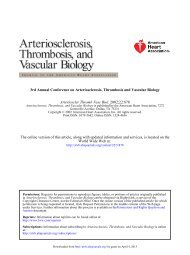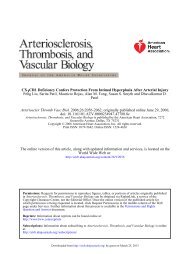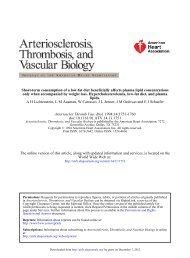Bloch and Richard T. Lee P. Christian Schulze, Heling Liu, Elizabeth ...
Bloch and Richard T. Lee P. Christian Schulze, Heling Liu, Elizabeth ...
Bloch and Richard T. Lee P. Christian Schulze, Heling Liu, Elizabeth ...
Create successful ePaper yourself
Turn your PDF publications into a flip-book with our unique Google optimized e-Paper software.
<strong>Schulze</strong> et al. NO regulates thioredoxin through Txnip-Supplemental Material - R1; page 3<br />
onto nitrocellulose membranes. Identical numbers of control <strong>and</strong> GSNO-treated cells were used for<br />
the isolation of nuclei <strong>and</strong> preparation of [ 32 P]UTP-radiolabeled transcripts. Signals were visualized<br />
by autoradiography. Specific radioactive signal intensity (as counts per minute) was determined for<br />
each probe individually using a scintillation counter <strong>and</strong> normalized over signal intensity of the<br />
housekeeping gene β-tubulin.<br />
mRNA stability. Cells were pretreated with actinomycin D (5 µg/mL for 30 min) before<br />
incubation with <strong>and</strong> without GSNO stimulation (100 µM) for varying durations. RNA was extracted,<br />
<strong>and</strong> Txnip gene expression was measured by quantitative PCR <strong>and</strong> normalized for expression of β-<br />
tubulin as described before. 3<br />
Plasmid construction <strong>and</strong> transient transfection experiments. The human Txnip promoter<br />
region including -1777 bp upstream of the ATG start codon was cloned from human genomic DNA<br />
using primers 1-6 (Table 1). To generate the Txnip promoter constructs, PCR products were<br />
extracted <strong>and</strong> cloned into a firefly luciferase reporter vector pGL3-Basic Vector (Promega). The<br />
transcriptional activity of the promoter constructs was assessed under stimulation with GSNO at 5.6<br />
mM <strong>and</strong> 22.4 mM glucose. Luciferase activity was determined using the Dual Light assay kit<br />
(Tropix). All experiments were repeated five times. Further, full-length human Txnip was cloned<br />
into a mammalian expression vector (pcDNA3.1, Invitrogen). Expression plasmids for human<br />
wildtype thioredoxin or mutant thioredoxin with a serine replacing cysteine 69 (C69S) were kindly<br />
provided by Dr. Judith Haendeler (Molecular Cardiology, University of Frankfurt, Germany). These<br />
vectors express a thioredoxin-Xpress-tag fusion protein. Complete sequence identity was confirmed<br />
by sequencing analysis. Cells were transfected using FUGENE transfection reagent (Roche Applied<br />
Biosystems) <strong>and</strong> were studied 48 hours later. Equal amounts of empty expression plasmids served<br />
as control vectors.<br />
Downloaded from<br />
http://atvb.ahajournals.org/ by guest on July 30, 2013














